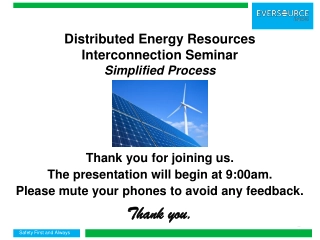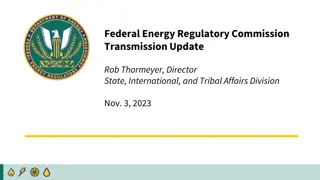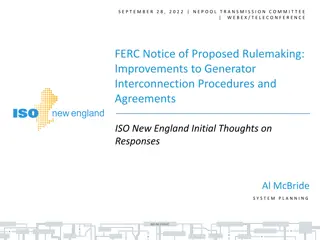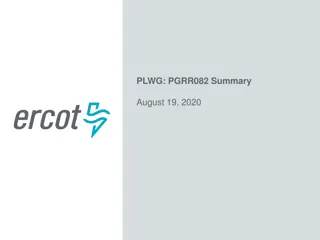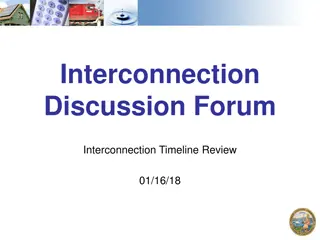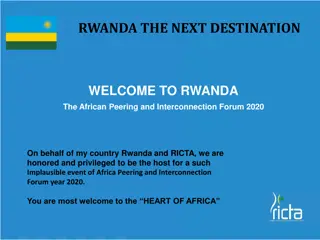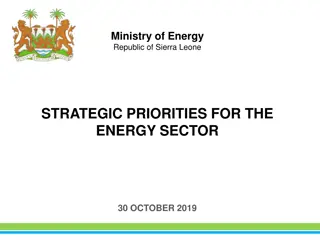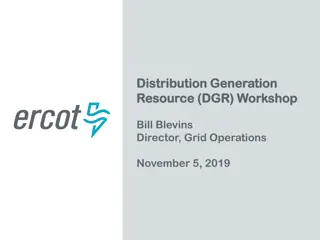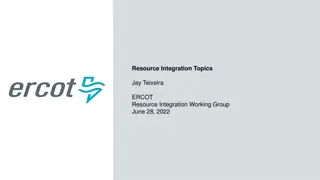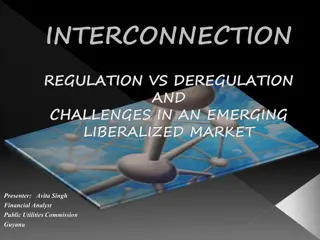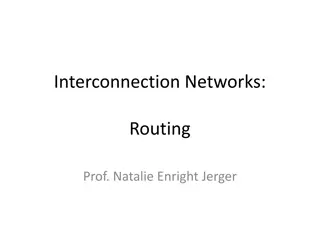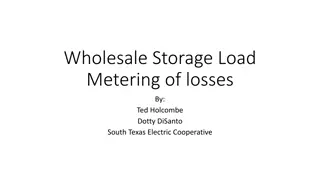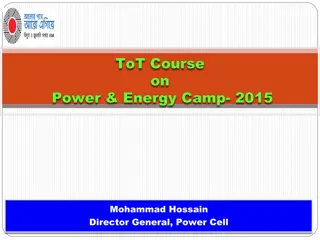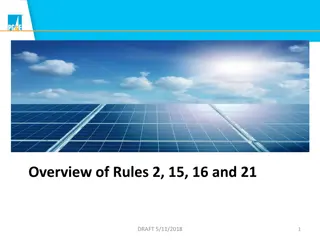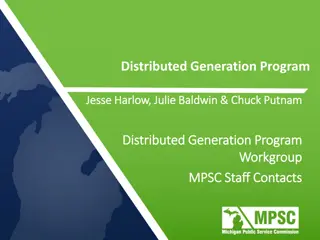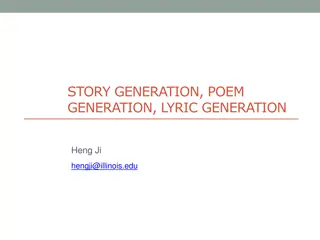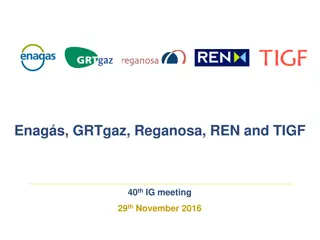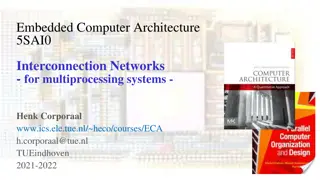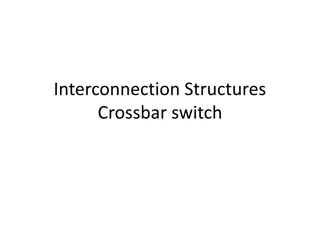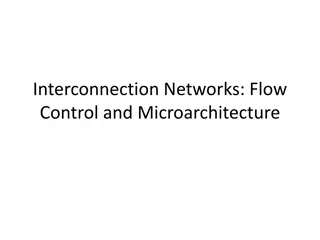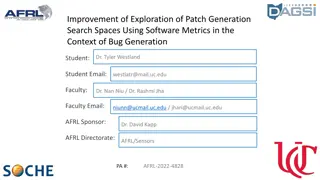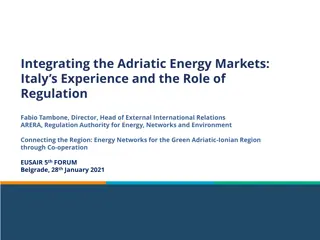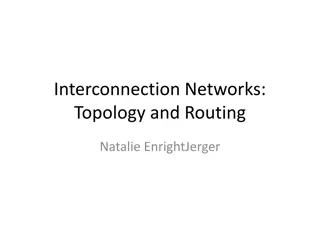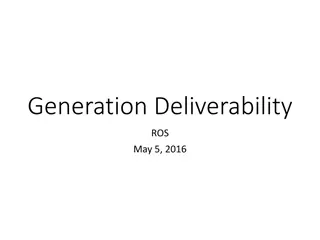Safety First and Always: DG Interconnection Seminar Process
Learn how to ensure safety while connecting Distributed Energy Resources. Understand the simplified process for interconnection, including key steps and safety precautions. Join us to enhance your knowledge and protect yourself and your team.
0 views • 26 slides
Federal Energy Regulatory Commission Transmission Update - Nov. 3, 2023
FERC, led by Director Rob Thormeyer, regulates natural gas wholesale facilities, interstate pipelines, onshore LNG facilities, wholesale electric market rates, and more. The Commission consists of five appointed Commissioners overseeing key initiatives like transmission planning proposals and interc
0 views • 14 slides
Improvements to Generator Interconnection Procedures: ISO New England Response
FERC's Notice of Proposed Rulemaking seeks to enhance generator interconnection procedures to address queue backlogs and promote fairness. ISO New England outlines expansive changes, including a first-ready, first-served process, and discusses trade-offs in project viability and completion expectati
0 views • 36 slides
Proposed Enhancements for Generator Interconnection Process
Enhancements proposed for the generator interconnection process include creating a distinction between large and small generators, establishing tracking processes for small generators, and modifying existing sub-sections to incorporate small and large generators in Sections 5 and 6. The goal is to s
1 views • 12 slides
Large Load Interconnection and Modification Guidelines
Ensure new or modified large loads are interconnected in a manner that maintains system reliability and complies with relevant standards and protocols. General provisions, interconnection agreements, procedures, and study processes are outlined to facilitate smooth integration within the ERCOT syste
0 views • 22 slides
Enhancing Information Retrieval with Augmented Generation Models
Augmented generation models, such as REALM and RAG, integrate retrieval and generation tasks to improve information retrieval processes. These models leverage background knowledge and language models to enhance recall and candidate generation. REALM focuses on concatenation and retrieval operations,
1 views • 9 slides
Comparison of 2nd vs 3rd Generation Fire Suppression Systems
The comparison highlights the evolution from 1st generation dry chemical agents to advanced 3rd generation systems like the Piranha Hybrid System, ensuring better fire protection in restaurants. It discusses the drawbacks of 2nd generation systems, emphasizing the need for improved fire suppression
1 views • 20 slides
Understanding Interconnection Networks in Multiprocessor Systems
Interconnection networks are essential in multiprocessor systems, linking processing elements, memory modules, and I/O units. They enable data exchange between processors and memory units, determining system performance. Fully connected interconnection networks offer high reliability but require ext
1 views • 19 slides
Interconnection Discussion Forum Timeline Review - 01/16/18
Interconnection Discussion Forum held on 01/16/18 discussed safety measures, meeting objectives, and timeline objectives. The agenda covered topics like submitting applications, engineering reviews, design, construction, and commissioning. Safety protocols for emergencies like earthquake and evacuat
0 views • 14 slides
Discover Rwanda: African Peering and Interconnection Forum 2020
Rwanda, the host of the African Peering and Interconnection Forum 2020, offers a remarkable blend of stunning scenery, friendly people, and economic development. With a focus on internet and ICT, the country boasts 4G LTE coverage, a growing MICE industry, investment opportunities, and accessibility
1 views • 8 slides
Evolution of MISO Interconnection Process: Enhancing Certainty and Efficiency
The MISO Interconnection Process has evolved over the years, reflecting improved certainty and efficiency. From historical trends to current statistics, the process highlights challenges, adjustments, and next steps to address issues like project dropouts, uncertainty in timing and costs, and entry
0 views • 11 slides
Strategic Priorities for Sustainable Electricity Generation in Sierra Leone
The Ministry of Energy in Sierra Leone has outlined strategic priorities to ensure sustainable electricity generation and supply in the short, medium, and long term. Key actions include implementing an integrated electricity plan, identifying externally funded projects for power supply, and addressi
0 views • 19 slides
DGR Interconnection Conditions Overview
Interconnection requirements for Distributed Generation Resources (DGR) include coordination with Distribution Service Providers (DSP), confirmation of operational limitations, and compliance with ERCOT regulations. These conditions ensure safe and efficient integration of DGRs into the electrical g
0 views • 19 slides
Interconnection Discussion Forum Projects Update
Update on interconnection activities, projects over 1MW, and themes discussed in the forum. Includes meeting objectives, agenda topics, inquiry themes, and PG&E interconnection updates on process changes and completed/planned actions.
0 views • 15 slides
Updates on Generator Interconnection Procedures and Agreements Reform
ISO-NE is implementing further compliance reforms in response to FERC Order No. 845 regarding Generator Interconnection Procedures and Agreements. This includes proposed tariff language updates and discussions on surplus interconnection services. The changes aim to enhance the efficiency and effecti
0 views • 14 slides
Resource Integration Topics for Large Generation Projects: Planning and Synchronization
The resource integration topics discussed in the ERCOT Working Group cover Quarterly Stability Assessment (QSA) planning, synchronization dates, issues related to previous QSAs, and the process for large generation projects seeking simultaneous screening and full interconnection studies. Key deadlin
0 views • 15 slides
Interconnection Regulation vs. Deregulation Challenges in an Emerging Liberalized Market
Interconnection between telecommunication networks and services plays a vital role in enhancing value for subscribers and facilitating the provision of a wide range of services. Regulation of interconnection is essential to protect competition, achieve social objectives, manage scarce resources, ens
0 views • 22 slides
Global Energy Interconnection and Power Grid Interconnections
Global Energy Interconnection (GEI) envisions globally interconnected power grids supporting clean, renewable energy transmission worldwide. Ultra-high voltage technology enables efficient long-distance power transmission. The concept originated in the 20th century and was endorsed by the United Nat
1 views • 40 slides
Understanding Routing in Interconnection Networks
Routing in interconnection networks involves distributing traffic evenly among paths to avoid hotspots and contention, aiming for balanced throughput. Various routing algorithms, such as greedy, uniform random, and adaptive, are discussed with examples highlighting their impact on network performanc
2 views • 38 slides
Comprehensive Overview of Sewage Treatment Plant Processes and Energy Generation
This seminar presentation dives deep into the world of sewage treatment plants, covering definitions, introduction, STP treatment stages (including primary, secondary, and tertiary treatments), energy generation through microbial fuel cells, and biogas generation. It emphasizes the importance of tre
0 views • 15 slides
Understanding Interconnection Networks Topology
Exploring the topology of interconnection networks helps determine the arrangement of channels and nodes, impacting network cost, performance, latency, energy consumption, and complexity of implementation. Abstract metrics such as degree, hop count, and network diameter play crucial roles in evaluat
1 views • 56 slides
Development of Attosecond Theory for Nobel Prize through Verilog Programming
Attosecond generation is a crucial technique for creating attosecond pulses by manipulating radiation waves. This research paper focuses on developing the Attosecond generation equation through Verilog programming and validating it using test programming techniques. The interface between equations,
0 views • 15 slides
McGill First Generation Orientation Event
The McGill First Generation Orientation event, organized by Campus Life & Engagement, took place on August 31st, 2021. The event highlighted the importance of supporting first-generation students and fostering allyship with Indigenous communities. It featured various sessions including introductions
0 views • 20 slides
Wholesale Storage Load Metering of Losses in Distributed Generation Battery Facility
Example system configuration in ERCOT involving a wholesale storage load metering system to track losses in a distributed interconnected generation battery facility. The system includes electrical storage systems, generation resources, and distribution generation components. Challenges arise in dete
0 views • 8 slides
Overview of Power Sector Growth and Expansion in Recent Years
In the last six years, the power sector has shown significant growth in terms of generation capacity, access to electricity, and reduction in system losses. The generation capacity has increased, transmission and distribution lines have expanded, and there has been a notable rise in per capita gener
0 views • 18 slides
Understanding Rules 2, 15, 16, and 21 in Utility Interconnection
This draft provides an overview of rules governing utility interconnection, focusing on Rules 2, 15, 16, and 21. It outlines meeting and learning objectives related to policy questions, mitigation costs, and interconnection timelines. Definitions of Line Extension (Rule 15) and Service Extension (Ru
0 views • 46 slides
Distributed Generation Program Overview and Updates
The Distributed Generation Program, as outlined in PA 342, aims to establish a tariff continuation of the current net metering program until the completion of 2018 rate cases. Key elements include eligibility for various generators, size limits, qualifying for net metering based on project size, own
0 views • 16 slides
Advancements in Text Generation and Comprehension Modeling
Cutting-edge research in coherent story generation, surface realization models, story ending generation, and animation generation is showcased. The models produce distribution over vocabulary and next token prediction for generating text and handling complex sentences seamlessly.
0 views • 40 slides
Gas Interconnection Agreements and Balancing Implementation Insights
Gas industry stakeholders Enags, GRTgaz, Reganosa, REN, and TIGF collaborated on various public consultations and discussed the implementation of Balancing Network Codes. Key topics include interconnection agreements, exceptional event situations, local products for balancing services, and the publi
0 views • 13 slides
Interconnection Networks in Multiprocessing Systems Overview
Explore the intricacies of interconnection networks for multiprocessing systems in Embedded Computer Architecture, covering connecting processors, topologies, routing, deadlock, switching, and performance metrics like bandwidth and latency. Delve into various network types, such as on-chip networks
0 views • 33 slides
Understanding Crossbar Switch Interconnection Structures
Interconnection structures like crossbar switches consist of crosspoints that control the pathways between processors and memory modules. The switch determines the transfer path and resolves access requests on a priority basis. Through multiplexers and arbitration logic, crossbar switches enable sim
0 views • 6 slides
Understanding Interconnection Networks, Flow Control, and Microarchitecture
Interconnection networks play a crucial role in determining the flow control and routing paths within a network, impacting throughput and latency. Different switching techniques like circuit-switching, packet-based, and flit-based control the allocation of resources at various granularities. Circuit
0 views • 41 slides
Exploration of Patch Generation Search Spaces using Software Metrics
This research focuses on improving the exploration of patch generation search spaces by utilizing software metrics in the context of bug generation. The study investigates the threat of malicious code insertion in third-party code construction for military projects and explores the concept of Patch
0 views • 8 slides
Integrating Adriatic Energy Markets: Italy's Regulatory Perspective
The presentation delves into Italy's experience in integrating Adriatic energy markets and the crucial role of regulation by ARERA. Exploring the promotion of markets integration, the talk highlights regulatory convergence in practice through projects like the MONITA interconnection. Italy's Regulat
0 views • 17 slides
Channel Generation Process for IEEE 802.11aj (45GHz) Based on Channel Measurement
This presentation by Haiming Wang and team from SEU/CWPAN discusses the process of channel realization and generation in the 45 GHz bandwidth. It covers the generation of the channel impulse response, modeling of parameters, statistical measurements, and future work related to the 802.11ad standard.
0 views • 27 slides
Understanding Interconnection Networks: Topology and Routing
Interconnection networks play a crucial role in determining the arrangement of channels and nodes within a network, similar to a road map guiding traffic flow. Topology overview defines the network structure, while abstract metrics help evaluate performance and cost. Latency and throughput are key f
0 views • 49 slides
Evolution of Generation Deliverability Criteria in ERCOT
ERCOT's journey towards enhancing generation deliverability criteria involves requests for transmission planning considerations, workshops on tool development, and discussions on economic criteria revisions. The focus is on addressing generation constraints at peak load conditions and assessing the
0 views • 7 slides
Comparison of Generator Governor Dead-band Settings in ERCOT Interconnection
This report compares the generator governor dead-band settings in the ERCOT Interconnection for the years 2008 and 2015 from January to November. It outlines the changes in the dead-band settings over the years, including the requirements for proportional response, improvements in primary frequency
0 views • 17 slides
Understanding Interconnection Networks in Embedded Computer Architecture
Explore the intricacies of interconnection networks in embedded computer architecture, covering topics such as connecting multiple processors, topologies, routing, deadlock, switching, and performance considerations. Learn about parallel computer systems, cache interconnections, network-on-chip, sha
0 views • 43 slides
Enhancing Western Interconnection Congestion Management
Addressing congestion management challenges within the Western Interconnection through the Western Interconnection Unscheduled Flow Mitigation Plan (WIUFMP). The plan focuses on curtailing tagged energy transfers during critical events and optimizing generation-to-load impact calculations, aiming to
0 views • 23 slides
